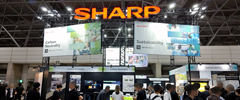“TV in the near Future” Revealed at Hackathon Hosted by SHARP
November 21, 2023
“What is the value of a television? Can that be changed?”
This is a report about the three exciting days where challengers faced these vague questions.
From November 10 to 12, a hackathon event targeting TVs “Future AQUOS Hackathon in SHARP Tech-Day,” was held at SHARP Tech-Day, a large-scale independent event held by the company at Tokyo Big Sight.

Tokyo Big Sight

The venue of SHARP Tech-Day
A hackathon is an event in which participants develop applications or product prototypes within a set timeframe in response to a specific theme, and compete for the novelty of their ideas and the excellence of their technologies.
The theme we set this time was “Let’s Change the Value of a Television!”
25 participants of 9 teams were invited to create solutions or develop applications that would change the value of TVs in just 3 days.
Applications developed with tremendous speed
At the beginning of the session, Mr. Yuya Kikukawa, President of ORPHE Inc., and facilitator of the hackathon, explained the aims and overall rundown of the hackathon.

This is the venue of the hackathon.

Each team was provided with an AQUOS TV along with other development devices, including USB cameras. Development was proceeded while actually running the applications being created.

Some of you might argue, “Television is for watching TV dramas and variety shows, so it can be replaced with smartphones and tablet PCs, right?”
The key to victory in this hackathon seems to be how such values can be changed.

Despite the time constraints, the hackathon proceeded in a serious yet cheerful atmosphere.

The final day of the event arrived faster than imagined.
Each team was given 3 minutes for presentation condensed with excitement!
It is time for the teams to deliver their presentations to the judges. Each team was given 3 minutes to make their presentation. Making the presentation easy to understand and interesting in that short time was important.

Presentations full of humor caught the audience with laughter.

After all teams finished their presentations, the judges moved to another room to decide the winners.
Everyone nervously waits for the result. And the grand prize goes to…
Finally, the award ceremony. Although it was difficult to choose the best idea, the first place had to be decided. Heated discussions even caused a slight delay in announcing the winners.
The award ceremony was conducted by Mr. Kikukawa and Mr. Kazuo Kanemaru, Director of Open Innovation Center, R&D Division of Sharp, who promoted this hackathon.

Mr. Kanemaru (left) and Mr. Kikukawa
On stage, each team once again presented their ideas. All of them sound interesting and deserve to be realized.

I had no idea which team would win.

With the presentations concluded, the Special Award was announced.
The Special Award went to the “BOCCHI DE CLAPPY SYNDROME” team!

Their theme was “TV is the Favorite in Spatial Computing.”
Spatial computing technology realizing virtual monitors in front of the user’s eyes by equipping a head-mounted display to display movies and computer screens as if viewing on a large screen has been evolving in recent years. This idea was to realize it on a TV. The prototype showed as if a virtual three-dimensional space spread out beyond the screen when you looked into the TV.
Next up was the Excellence Award winner.
The Excellence Award went to the “TODOROKI” team!

Their theme was “MIRUYOKU” – The more you watch (MIRU) TV, the better (YOKU) the world becomes.
It was a system in which the person watching the TV is taken by a camera, and coins are given when their eyes are drawn to advertisements. The coins can be donated to fundraising organizations, and the viewer will receive a small token of appreciation or a small gift in return. The scores of the viewer will be recorded to stimulate their moral motivation too. The idea is that the more you watch TV, the more you can contribute to society.
And finally, the grand prize winner was announced.
The Grand Prize went to the “Yukai na Nakama Tachi” team!

Their theme was “AI Family Assistant to stand close by the family”.
The idea is that an AI-equipped TV becomes an assistant for the family. The AI will automatically analyze the products and services shown on the TV that the family members might be interested in and enabling to purchase them with virtual currency, or communicate about impressions of the TV program. The prototype demonstrated how list of home appliances was created based on the shown video, and how you can purchase directly from that list.
After comments
The judges gave their comments at the end of the hackathon.
First, from Professor Shigeru Kobayashi of the Institute of Advanced Media Arts and Sciences:

The TV is placed in the best place in the living room, and it is always connected to power. I felt there is still freedom on interpreting this meaning, and I was reminded that if we can interpret it well, we can create various values.
Next, Mr. Tasuku Mizuno, lawyer, outside director of note inc., and a member of the Good Design Award judge:

I feel it is very valuable for a big company like Sharp to engage in this kind of open innovation. For example, in this hackathon, we focused on the possibilities of TVs which is used in very private spaces. When a big company takes on such developments, it is often interrupted by privacy and information protection issues. I think it is very important to first create a demo and let people’s imagination run freely. I am convinced that the next seed is hidden in such a place.
Next, Mr. Mototaka Taneya, Managing Executive Officer, CTO, Head of R&D, and Head of Corporate Research & Development Group at Sharp:

First of all, I would like to thank all contestants for the hard work over these three days. I am very grateful for thinking about TVs with such intensity. The opinions of the judges were split, and heated discussions were made on who to choose among such high level of entries. All the themes were very attractive. We held this hackathon with the idea that we cannot change things if we think only within Sharp. We received many great opportunities from your ideas. Regardless of the winning team, let’s think together for the next phase.
Finally, Professor Osamu Ogasawara of Kyoto University of Arts, who has massively contributed in organizing the hackathon:

We chose the winners based on what kind of thematic setting and ease of conveying the message. Just as you saw, how the TV was actually in the center of spatial computing, how watching TV can make the world a better place, or how the TV can be an assistant to the family. If these become a reality in another few years from now, everyone here is a witness of their first appearances. It is really fun to create something, and I think Sharp’s staff members involved in this project also enjoyed the time here. I have seen how such enthusiasm of each and every member can change a large organization, and I hope that you will carry on this enthusiasm even after event is over.
The hackathon event ended with a commemorative photo.

A hackathon is packed with the steps necessary to launch a new business, such as understanding the theme, analyzing the market, creating novel ideas, and developing them within time. The imagination, skills, and above all, the enthusiasm of the challengers were truly amazing. What changes the world is not necessarily something that takes time to develop. I felt that a moment of inspiration and action can become “the norm in a near future.
How will this hackathon change the value of a television? I would like to keep you informed on future developments.
(Public Relations M)
SHARP Open Incubation:https://oi.jp.sharp/




